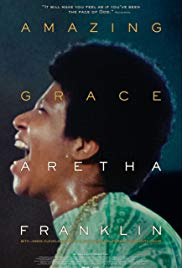
AMAZING GRACE
US, 1971/2019, 88 minutes, Colour.
Aretha Franklin, James Cleveland, Alexander Hamilton, C.L,Franklin, Clara Ward.
Directed by Allan Elliot, Sydney Pollack.
John Newton, the 18th century composer of the celebrated hymn might have had an amazing and graced experience if he saw and heard Aretha Franklin’s version in this film record.
The documentary was unexpected. It is a record of two nights of recording the Amazing Grace album with Aretha Franklin, not in a studio, but in a church accompanied by musician and singer, her longtime friend, Rev James Cleveland. The recording was made in 1971. Warner Brothers was interested at the time and sent director, Sidney Pollack, was emerging after some years of filmmaking, including They Shoot Horses, Don’t They, as a leading Hollywood presence – as he continued over several decades. He can be seen in several scenes discussing with technicians and taking close-ups of Aretha Franklin.
However, the report was that the clapper board was not used to identify all the sequences and takes, and that there were five cameras in the church for the event. Which meant then that it was too difficult, technically, to match the voice recording with the visuals and the project was abandoned – and some comment that Aretha Franklin was not happy with the process.
But, there have been extraordinary developments in technology, and Aretha Franklin is named as one of the producers of this film, a painstaking editing, sound and image synchronising, and, after almost 50 years, an opportunity for audiences to share in the experience of the event and, of course, of Aretha Franklin’s voice.
One of the aspects that audiences will notice about this film is how much hard work goes into performance, performance under lights and cameras, sweat glistening frequently from both Aretha Franklin and James Cleveland, at one stage, her father getting active and wiping his daughter’s face. (He is actually present for the second night of recording, obviously proud of his daughter, reminiscing about her singing when she was six or seven, going on tour with him preaching, his Baptist ministry which was based in Detroit, and her further career – both secular and, as with this album, a collection of songs and hymns she sang during her childhood.)
She wanted to do the album with a live audience and with that extraordinary and active participation that the congregations, especially African-American? congregations, bring to their services and expressing their faith. Featured here is a Southern Californian Choir, under the extraordinarily active and enthusiastic direction of Alexander Hamilton, and many shots of them and the broad congregation singing, calling out, affirming, standing and waving, some young people enthusiastically dancing. (And, there are some glimpses of Mick Jagger in the congregation sharing some of that enthusiasm and action.)
This is not a smooth production. There are explanations that when mistakes are made there will be new beginnings of songs, people having to remember the words that were sung or shouted when filming was interrupted! So, there is a great deal of material which could be described as “behind-the-scenes� but which become integral to the scenes.
Of course, the key to the whole film and the restoration is to see and hear Aretha Franklin and the great range of songs and hymns that she performs. We are amazed at her versatility, her range, here timing, her vocal virtuosity, her commitment to the songs and their faith and religious dimensions.